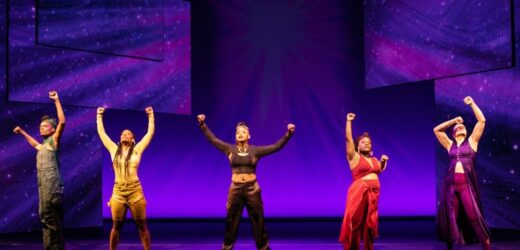On September 15, 1976, Ntozake Shange’s “for colored girls who have considered suicide / when the rainbow is enuf” opened at the Booth Theatre, forever reshaping the form and feel of American theatre. On Wednesday evening in New York City, “for colored girls” returned to the Booth Theatre for its first exuberant revival on Broadway.
Then, “for colored girls,” a collection of poetic monologues, set the Broadway stage for Black women to speak and introduced a theatrical form made for its telling: The “choreopoem,” a device of Shange’s invention, bent the conventions of spoken word, poetry and dance to the needs of Black women. It also shared 45th Street with another work busy remaking the theatrical canon, “A Chorus Line.”
As “for colored girls” returns to Broadway a generation or two later, it carries a new milestone. Tony-nominee Camille A. Brown makes her directorial debut and becomes the first Black woman to direct and choreograph a show on Broadway.
“This is a play that’s passed down between Black women,” Brown told Variety on opening night. “It was passed to me from my mother, who told me ‘don’t ever let anyone take your stuff away.’ She didn’t tell me until a few years ago that the line was from the play. ‘For colored girls’ is literally passed between women in that way, but it’s also a spiritual passing of information, love, vulnerability and sisterhood.”
“The aspect of Black women coming together in a space to empower each other is something that’s necessary for me,” she continued. “As Black women, there is necessity to our collectivity.”
Community was Shange’s political weapon of choice. In “for colored girls,” each poem and monologue introduces the women on stage to each other, to the kindnesses and cruelties they share. The community they capture denies the pervasive power of misogyny, configures their interrelation as a place of strength, and offers a model of grassroots feminism that remains essential today.
“Ntozake might have been disappointed that this play remains contemporary,” Donald Sutton, a representative from the playwright’s estate, told Variety on opening night. Shange died in 2018 at 70 years old. “Sorrow, agency, reproductive health are still frontline news. I don’t think she’d be particularly happy about that, but I know that she’d love to know that another generation of African American women will see the show again.”
Another generation of Broadway audiences, too.
“Our bodies need to move to express a certain thing that we can’t articulate with words. That remains unique in ‘for colored girls,’” Kenita Miller, who plays Lady in Red, told Variety. “That remains a kind of theatrical storytelling that Broadway has yet to take in stride, to use for all its lessons.”
True, “for colored girls” returns to Broadway amidst an artistic era less willing to bend form for the purpose of story, hackneyed with one musical-film adaptation after another. If “for colored girls” was first charged by movements toward Black Nationalism and pan-Africanism, it also returns amidst an equally heated political environment. A joyous one, too.
“Once can’t help but to be proud of being a Black woman on stage,” Miller continued before the show on Wednesday. “Justice Jackson and her confirmation: We watched her maneuver with such elegance, such grace against incredible obstacles. In her performance were several hues of this rainbow.”
“I hope she comes so we can say thank you,” Miller continued, gesturing toward her stomach. The actor — who is joined onstage by Amara Grandson, Tendayi Kuumba, Okwui Okpokwasili, Stacey Sergeant, Alexandria Wailes, and D. Woods — is eight months pregnant with a baby girl.
“Yes, theater is generational. This is my first child,” she said. “There’s a moment in this show where everyone touches her, a laying on of hands. I feel fortified by the strength of all these women. Blessings like that are why Shange made this play.”
Source: Read Full Article


